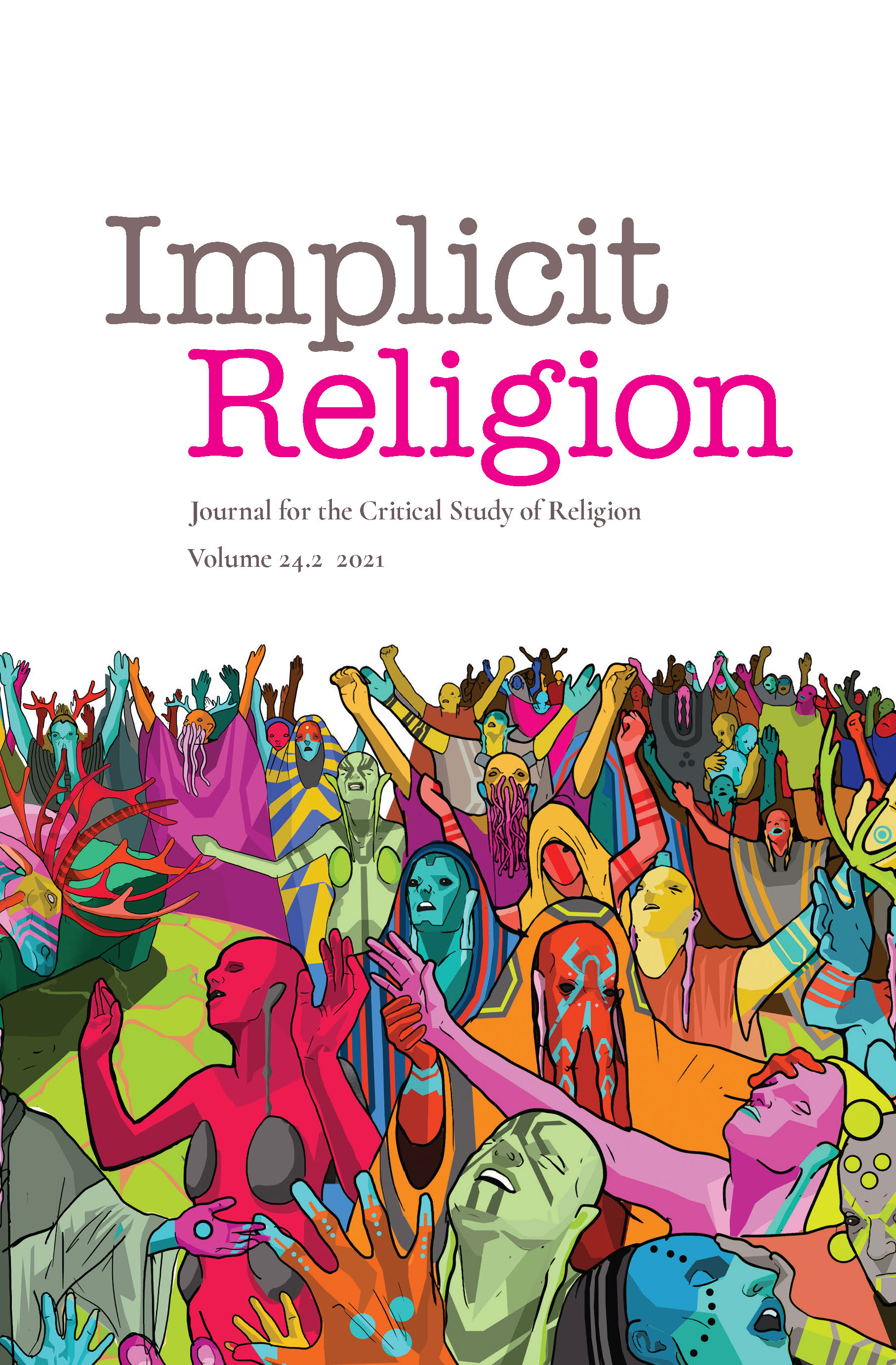Past the Pejorative
Understanding the Word “Cult” Through Its Use in American Newspapers During the Nineties
DOI:
https://doi.org/10.1558/imre.23202Keywords:
cult, media, rhetoric, United States, press, discourseAbstract
Within the academic study of New Religious Movements, it has become standard to understand “cult” as a pejorative term which is dismissive of minority religions and in some cases harms them. This article, through a quantitative content analysis conducted by the author of various uses of the word “cult” in twenty-five American newspapers through the 1990s, is an attempt to understand, in detail and supported by data, how “cult” was applied to particular religious groups and used more widely within popular discourse. It argues that the word “cult” was primarily used for subjects that were not religious groups, and when it was applied to religious groups, it was largely done so to a very small number that all shared several characteristics. It further argues that “cult” should be understood
as a complex term with a range of meanings and applications.
References
Abbot, Stacey, ed. 2010. The Cult TV Book. London: I.B. Tauris. https://doi.org/10.5040/9780755697564
Atkin, Douglas. 2004. The Culting of Brands: When Customers Become True Believers. New York: Penguin.
Arweck, Elisabeth. 2005. Researching New Religious Movements: Responses and Redefinitions. London: Routledge. https://doi.org/10.4324/9780203642375
Barker, Eileen. 2004. “Perspective: What are we studying?” Nova Religio 8(1): 88–102. https://doi.org/10.1525/nr.2004.8.1.88
Beckford, James A. 1985. Cult Controversies: The Societal Response to New Religious Movements. London: Tavistock Publications.
Bell, Charles W. 1990. “A new sun shines in M-World.” New York Daily News. July 13.
Dailey, Kate, Journalist. 2011. “The Cult of Steve Jobs,” BBC News Magazine. October 7. https://www.bbc.com/news/magazine-15194365
Dawson, Lorne L. 2007. “The meaning and sacrifice of New Religious Movements.” In Teaching New Religious Movements, edited by David G. Bromley, 115–134. Oxford: Oxford University Press. https://doi.org/10.1093/acprof:oso/9780195177299.003.0006
Doctorow, Cory, Journalist. 2020. “Against the cult of Apple.” Slate. January 15. https://slate.com/technology/2020/01/against-the-cult-of-apple.html
Gallagher, Eugene V. 2004. The New Religious Movements Experience in America. Westport: Greenwood Press.
Goodman, Ellen, Journalist. 1997. “Right up there with James Dean and Evita.” Baltimore Sun. September 3.
Goodwin, Megan. 2018. “Unpacking the bunker: Sex, abuse, and apocalypticism in ‘Unbreakable Kimmy Schmidt’.’’ Crosscurrents, June: 1–23. https://doi.org/10.1111/cros.12310
———. 2021. “Bombing American religion to save it: A review of Richard Kent Evans’s book MOVE: An American Religion.” The Revealer. September 9. https://therevealer.org/bombing-american-religion-to-save-it/
Hills, Matt. 2002. Fan Cultures. London: Routledge. https://doi.org/10.4324/9780203361337
Hughes, Sarah A. 2021. American Tabloid Media and the Satanic Panic, 1970–2000. London: Springer Nature. https://doi.org/10.1007/978-3-030-83636-8
Hyken, Shep. 2009. The Cult of the Consumer: Create an Amazing Customer Experience That Turns Satisfied Customers into Customer Evangelists. Hoboken, NJ: John Wiley & Sons.
Jakobsh, Doris. 2008. “3HO/ Sikh Dharma of the Western Hemisphere: The ‘forgotten’ New Religious Movement?” Religion Compass 2(3): 385–408. https://doi.org/10.1111/j.1749-8171.2008.00068.x
Jenkins, Philip. 2000. Mystics and Messiahs: Cults and New Religions in American History. Oxford: Oxford University Press.
Kahney, Leander. 2004. The Cult of Mac. San Francisco: No Starch Press.
———. 2005. The Cult of iPod. San Francisco: No Starch Press.
Laskow, Sarah. 2015. “We asked a cultural historian: Are Apple stores the new temples?” Atlas Obscura. September 25. https://www.atlasobscura.com/articles/we-asked-a-cultural-historian-are-apple-stores-the-new-temples
Laycock, Joseph. 2013. “Where do they get these ideas? Changing ideas of cults in the mirror of popular culture.” Journal of the American Academy of Religion 81(1): 80–106. https://doi.org/10.1093/jaarel/lfs091
Lewis, James R. 2004. “Overview.” In The Oxford Handbook of New Religious Movements, edited by James R. Lewis, 3–15. Oxford: Oxford University Press.
Mathijs, Ernest and Jamie Sexton. 2011. Cult Cinema: An Introduction. West Sussex: Wiley-Blackwell. https://doi.org/10.1002/9781444396447
McCloud, Sean. 2004. Making the American Religious Fringe: Exotics, Subversives, and Journalists, 1955–1993. Chapel Hill: University of North Carolina Press. https://doi.org/10.1525/nr.2005.9.1.109
McCollum, Brain. 1999. “Maxwell returns with a sizzling concert.” Detroit Free Press. August 27.
Melton, J. Gordon. 2004. “Perspective: Towards a definition of ‘New Religion’.’’Nova Religio 8(1): 73–87. https://doi.org/10.1525/nr.2004.8.1.73
———. 2007. “Perspective: New New Religions.” Nova Religio 10(4): 103–112. https://doi.org/10.1525/nr.2007.10.4.103
Moore, Rebecca. 2003. “Drinking the Kool-Aid: The cultural transformation of a tragedy.” Nova Religio 7(2): 92–100. https://www.jstor.org/stable/10.1525/nr.2003.7.2.92
———. 2009. Understanding Jonestown and Peoples Temple. Santa Barbara: ABC-CLIO.
Moore, Rebecca, Anthony B. Pinn, and Mary R. Sawyer (eds.). 2004. Peoples Temple and Black Religion in America. Bloomington: Indiana University Press.
Neal, Lynn S. 2011. “‘They’re freaks!’: The cult stereotype in fictional television shows, 1958–2008.” Nova Religio, 14(3): 81–107. https://doi.org/10.1525/nr.2011.14.3.81
Olson, Paul J. 2006. “The public perception of ‘cults’ and ‘New Religious Movements’.” Journal for the Scientific Study of Religion 45(1): 97–106. https://doi.org/10.1111/j.1468-5906.2006.00008.x
Plamper, Jan. 2012. Stalin Cult: A Study in the Alchemy of Power. New Haven, CT: Yale University Press.
Plaschke, Bill. 2000. “Good Knight or Goodbye.” Los Angeles Times. May 16.
Ragas, Matthew W. and Bolivar J. Bueno. 2002. The Power of Cult Branding: How 9 Magnetic Brands Turned Customers into Loyal Followers (and Yours Can, Too!). New York: Prima Publishing.
Reeves, Jimmie L., Mark C. Rodgers and Michael Epstein. 1996. “Rewriting popularity: The cult files.” In “Deny All Knowledge”: Reading the X-Files, edited by David Lavery, Angela Hague and Marla Cartwright: 22–35. Syracuse: Syracuse University Press.
Richardson, James T. 2006. “Cult and New Religions.” In The Encyclopedia of New Religious Movements, edited by Peter B. Clarke, 144–147. London: Routledge.
Shupe, Anson D., David G. Bromley and Donna L. Oliver. 1984. The Anti-Cult Movement in America: A Bibliography and Historical Survey. New York: Garland Publishing.
Shupe, Anson, David G. Bromley and Susan E. Darnell. 2004. “The North American anti-cult movement: Vicissitudes of success and failure.” in The Oxford Handbook of New Religious Movements, edited by James R. Lewis, 184–205. Oxford: Oxford University Press. https://doi.org/10.1093/oxfordhb/9780195369649.003.0009
Smith, Iain Robert. 2020. “What is cult when it’s at home? Reframing cult cinema domestic space.” In Film and Domestic Space, edited by Stefano Baschiera and Miriam De Rosa, 210–225. Edinburgh: Edinburgh University Press. https://doi.org/10.1515/9781474428941-017
Tamayo, Juan O. 2000. “The secret to Castro’s success: President Keeps his personal life out of spotlight.” The Charlotte Observer. October 29.
Wessinger, Catherine. 2000. How the Millennium Comes Violently: From Jonestown to Heaven’s Gate. New York: Seven Bridges Press.
Young, Cathy. 1991. “Worshipping at the altar of environmentalism.” Detroit Free Press. January 6.


